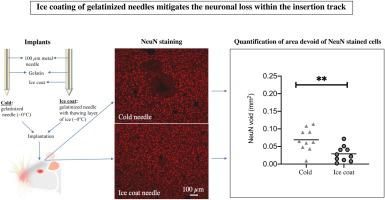Journal of Neuroscience Methods ( IF 3 ) Pub Date : 2020-07-03 , DOI: 10.1016/j.jneumeth.2020.108842 Mohsin Mohammed 1 , Jonas Thelin 1 , Lina Gällentoft 1 , Palmi Thor Thorbergsson 1 , Lucas S Kumosa 1 , Jens Schouenborg 2 , Lina M E Pettersson 2

|
Background
Reduction of insertion injury is likely important to approach physiological conditions in the vicinity of implanted devices intended to interface with the surrounding brain.
New methods
We have developed a novel, low-friction coating around frozen, gelatin embedded needles. By introducing a layer of thawing ice onto the gelatin, decreasing surface friction, we mitigate damage caused by the implantation.
Results and comparison with existing methods
The acute effects of a transient stab on neuronal density and glial reactions were assessed 1 and 7 days post stab in rat cortex and striatum both within and outside the insertion track using immunohistochemical staining. The addition of a coat of melting ice to the frozen gelatin embedded needles reduced the insertion force with around 50 %, substantially reduced the loss neurons (i.e. reduced neuronal void), and yielded near normal levels of astrocytes within the insertion track 1 day after insertion, as compared to gelatin coated probes of the same temperature without ice coating. There were negligible effects on glial reactions and neuronal density immediately outside the insertion track of both ice coated and cold gelatin embedded needles. This new method of implantation presents a considerable improvement compared to existing modes of device insertion.
Conclusions
Acute brain injuries following insertion of e.g. ultra-flexible electrodes, can be reduced by providing an outer coat of ultra-slippery thawing ice. No adverse effect of lowered implant temperature was found, opening the possibility of locking fragile electrode construct configurations in frozen gelatin, prior to implantation into the brain.
中文翻译:

覆冰-一种减轻脑部急性损伤的新方法。
背景
减少插入损伤对于在旨在与周围大脑对接的植入设备附近处理生理状况可能很重要。
新方法
我们已经开发了一种新颖的,低摩擦的涂层,围绕着冷冻的明胶嵌入式针头。通过在明胶上引入一层融化的冰,减少表面摩擦,我们减轻了植入引起的损坏。
结果和与现有方法的比较
使用免疫组织化学染色,在插入轨迹内外的大鼠皮层和纹状体中,在大鼠皮层和纹状体刺伤后第1天和第7天,评估了短暂性刺伤对神经元密度和神经胶质反应的急性影响。在冰冻的明胶埋入针中添加一层融化的冰层可将插入力降低50%左右,显着减少神经元的丢失(即减少神经元空隙),并在插入后1天内在插入轨迹内产生接近正常水平的星形胶质细胞与未涂冰的相同温度的明胶涂层探头相比。冰包胶和冷明胶嵌入针的插入轨迹外,对神经胶质反应和神经元密度的影响可忽略不计。
结论
可以通过提供一层超滑的融化冰来减少例如插入超柔性电极后的急性脑损伤。没有发现降低植入物温度的不利影响,打开了在植入大脑之前将易碎的电极构造锁定在冷冻明胶中的可能性。

























 京公网安备 11010802027423号
京公网安备 11010802027423号